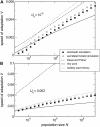The stochastic edge in adaptive evolution
- PMID: 18493075
- PMCID: PMC2390637
- DOI: 10.1534/genetics.107.079319
The stochastic edge in adaptive evolution
Abstract
In a recent article, Desai and Fisher proposed that the speed of adaptation in an asexual population is determined by the dynamics of the stochastic edge of the population, that is, by the emergence and subsequent establishment of rare mutants that exceed the fitness of all sequences currently present in the population. Desai and Fisher perform an elaborate stochastic calculation of the mean time tau until a new class of mutants has been established and interpret 1/tau as the speed of adaptation. As they note, however, their calculations are valid only for moderate speeds. This limitation arises from their method to determine tau: Desai and Fisher back extrapolate the value of tau from the best-fit class's exponential growth at infinite time. This approach is not valid when the population adapts rapidly, because in this case the best-fit class grows nonexponentially during the relevant time interval. Here, we substantially extend Desai and Fisher's analysis of the stochastic edge. We show that we can apply Desai and Fisher's method to high speeds by either exponentially back extrapolating from finite time or using a nonexponential back extrapolation. Our results are compatible with predictions made using a different analytical approach (Rouzine et al.) and agree well with numerical simulations.
Figures




References
-
- Abate, J., and P. P. Valkó, 2004. Multi-precision laplace transform inversion. Int. J. Numer. Methods Eng. 60 979–993.
-
- Athreya, K. B., and P. E. Ney, 1972. Branching Processes. Springer, New York.
-
- Baake, E., M. Baake and H. Wagner, 1997. Ising quantum chain is equivalent to a model of biological evolution. Phys. Rev. Lett. 78 559–562.
Publication types
MeSH terms
Grants and funding
LinkOut - more resources
Full Text Sources
Research Materials

